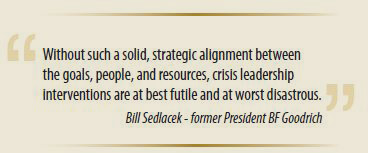
We’re all too familiar with the way a normal workday can be instantly blown apart by a major crisis.
Employee shooting!
Chemical spill!
Cybertechnology attack!
The list goes on and on.
These events are no longer conjured up by Hollywood screenwriters. They're part of our real world, here or abroad
When recruiting executives, we must look for candidates who have demonstrated an ability to lead through a crisis. Perhaps they've already dealt with crises during their careers. At the very least they must be aware of the value of crisis training and the need to respond
well — and quickly.
What Not To Do
So how do leaders prepare themselves and their teams to face a crisis? What leadership competencies are essential to successfully assessing risk and navigating through an actual crisis? (These are questions you or your headhunter should ask when recruiting executives.)
First, let’s look at 10 common mistakes leaders typically make during a crisis. Then, I’ll share the three key competencies for effective risk assessment and crisis leadership.
Based upon extensive research and a collaborative effort with crisis management experts from the Secret Service, military, CIA, and FBI, here is a list of top 10 mistakes made in a crisis. (These mistakes may be good fodder for conversations with potential executive recruits.)
Top Ten Mistakes Leaders Make in a Crisis
Mistake #1: Failure to plan.
General Dwight Eisenhower, the man behind the brilliant D-Day invasion plan that initiated the Allied victory in World War II, once said, “A plan is nothing; planning is everything.”
The most frightening and common mistake leaders make? They have no plan to follow before, during or even after a crisis strikes. Lacking foresight (risk assessment) and proper pre-crisis planning (crisis drills), leaders will simply apply shoot-from-the-hip solutions.
During a crisis, a leader must align three critical elements: the Goals, the People, and
the Resources.
- The goals define the
What
— the specific outcomes and objectives of the crisis intervention. - The people define the
Who
— getting the right people in the right positions with the right teams. - The resources define the
How
— tools the leaders will use as tangible and intangible resources to meet the goals.

You need a solid, strategic alignment among goals, people and resources. Otherwise, crisis leadership interventions will fail.
Mistake #2: Failure to determine & follow a hierarchy.
One very critical aspect of successful crisis navigation is establishment of a proper hierarchy of executive and field leadership — and commitment to following that hierarchy.
 Great crisis plans can quickly crumble in what normally would be an effective change of command. Even leaders with a preset crisis action template often fail to align the goals, people, and resources necessary to win during the crisis.
Great crisis plans can quickly crumble in what normally would be an effective change of command. Even leaders with a preset crisis action template often fail to align the goals, people, and resources necessary to win during the crisis.
This includes nuts and bolts, like something as simple as a basic Call Down List
of who to call, what their assignment is and how to reach them quickly (cell number, email, text).
Additionally, leaders must effectively handle the clashing egos
that often appear during a crisis. Known to crisis leadership experts as the Alexander Haig Syndrome
, a well-meaning person who improperly assumes control often does far more damage than good.
Such confusion can be eliminated with a well thought-out and communicated crisis hierarchy of command that is discussed and clearly understood before a crisis occurs.
Mistake #3: Failure to be visible, present and attentive.
A leader can only be in one place at one time. Yet leaders who hide or appear removed from the crisis negate their perceived and expected leadership actions. Be visible during and after the crisis in four areas: colleagues (crisis team and employees), customers, constituents (vendors, stockholders, suppliers), and communities (cities served, local and national media).
Remember how Mayor Rudy Giuliani acted during and then lead the chaotic days after the 9/11 terrorist attack? His multiple daily media appearances along with his hands-on approach in face-to-face meetings with many departments gave all New Yorkers (and the world) the necessary calm needed. We saw a visible leader at the helm.
Mistake #4: Failure to listen & comprehend.
This is a vital skill for leaders during a crisis: They must set aside their egos and be willing to listen to all parties involved. Only through powerful listening can a leader build the right environment of openness, trust, and professionalism necessary to navigate everyone
through the crisis. Even the simple act of taking notes (or even assigning a full-time scribe) is an invaluable listening tool that helps a leader assemble and digest the potentially powerful ideas of all involved.

Mistake #5: Failure to effectively communicate.
Communication equipment failures do commonly occur during crisis (fire department inside Twin Towers at 911, power & cell lines knocked down during Hurricane Katrina). Properly functioning communication equipment (telephones, cell phones, two-ways, Internet, text, email, etc.) is absolutely essential to leading a crisis. Avoid or minimize these risks by assessing them and establishing contingency plans before the crisis hits.
The majority of communication failures during a crisis are electronic equipment failures, although human communication failures are all too frequent during a crisis. Unclear goals, misunderstood instructions, poor delegation, incomplete feedback systems, lack of decision-making — these are the core communication failures in most crisis situations.
Leaders must continually focus on crafting and sending clear, unambiguous communications with minimal error for misinterpretation by their supervisors, peers, subordinates, customers, community or the media. Specific, concise, and action-focused language is essential to effectively connect with everyone impacted by the crisis.

Mistake #6: Failure to try things.
In a crisis, leaders must adapt and be willing to change quickly, to embrace new ways on the fly and to use problem-solving techniques never before imagined. And they must act without projecting fear.
Too often, good-hearted leaders rely too much on the “ways of yesterday” and let fear distract or even control them. In the
end, they fail to objectively find new ways to better respond to today’s immediate crises.
Leaders must therefore be adept in when and how (1) to innovate current encumbering systems, (2) create new and more flexible systems, and (3) effectively use their intuition.
By understanding the interconnected roles of innovation, creativity, and intuition, leaders are much better prepared to implement the best actions for today’s crisis environment.
Mistake #7: Failure to give up control.
Failure to give up control.
It is only natural for leaders to assume control over a crisis, and in fact, they should. The problem is when a leader refuses to give up enough control necessary to effectively negate
the crisis.
The well documented failure of the then Governor of Louisiana to allow the federal government quick access and control over the response efforts after Hurricane Katrina led to much higher levels of destruction and damage than was necessary.
In times of crisis, leaders must create an environment that moves beyond delegation (do what I tell you to do) to emancipation (giving people the freedom to succeed).
Proper delegation of the crisis plan and flexibility to adjust as circumstances rapidly change is essential to success.
Mistake #8: Failure to act.
Hesitancy often delays progress. Inappropriate indecision kills a response teams’ enthusiasm, motivation, and commitment
to succeed.
Leaders must therefore have the confidence to make the call — to pull the trigger — and do something. People want their leaders to show confidence even when they’re not 100 percent sure the leaders’ decisions will prove to be correct.
Such a call to action requires real courage, the willingness to act upon your convictions.
With a solid plan, surrounded by a well-trained crisis team, leaders are far more likely to take
the right action at the right time for the right reasons — to be truly courageous in the face
of tragedy.
Mistake #9: Failure to lead.
A crisis demands real leadership. No one can perfectly “manage” a crisis - there are too many variables. Only through real leadership (making tough choices, facing opposition, under extreme pressure) does a company, a community, or a nation survive.
Failure to lead during a crisis is not just a failure — it’s a tragedy. Those in charge must lead the crisis — or the crisis will lead them!
Mistake #10: Failure to debrief.
Most people just want to get through a crisis and forget about it. After cleaning up a semi-tractor trailer full of trash, tree limbs, and other debris the days following Hurricane Ivan, I remember desperately wanting to get back my phone lines, my internet connection, the electricity for my refrigerator, air conditioning and lights, and just put it all behind me!
But ask anyone — from a firefighter to a Navy Seal to a fighter jet pilot — and they will tell you about the incredible value of a post-event analysis often call a “Debrief Session.”
A Debrief Session
is a focused, well-structured, and comprehensive analysis that reviews the efficacy of the original goals and objectives, actions taken, leadership decisions and adjustments made, successes and failures, and perhaps most important, lessons learned to apply into
the future.
With a systematic debriefing process, leaders educate themselves and their entire organizations to be better prepared for the next crisis they face.
Three Essential Crisis Leadership Competencies
In the end, your leadership legacy may ultimately be judged by how well you prepared your company and navigated it through a crisis. Indeed, in today’s environment, you’re likely to deal with far more than just one crisis in your career — another reason to include this area when interviewing recruits for executive slots.
Regardless of your initiatives to increase earnings, bolster market share, raise stock prices, re-energize your brand or innovate new products, most often you will be remembered far more for your ability to navigate through a substantial crisis than for dominating a particular market.
Yet, it is reassuring to know that the three essential competencies for crisis leadership are exactly the same three skills you need for successful day-to-day corporate leadership.
It is also reassuring to know that these three competencies can be learned, honed, and elevated within any leader’s current skill set.
The three essential crisis leadership competencies are the ability to:
(1) Envision - to lead from strategy
(2) Engage - to lead through people
(3) Execute - to lead for transformational results.
A leader needs all three to be highly effective. They particularly need all three when leading through a crisis.
If entire leadership teams are properly trained and equipped with these essentials, they are prepared to face any crisis with high confidence, competence, and commitment. It therefore behooves any forward-thinking leadership team to take their collective crisis leadership skills to a higher level NOW before your next major crisis hits.
Assess your risks, prepare for crisis now. Waiting for a better time, or when your “schedule frees up” may simply be too late. For tomorrow, you may actually wake up, forced to face your next crisis. Are you ready?





